(CTTO)
Spanish Colonial CoinsValues of Spanish Colonial Coins.
One of the most fascinating areas of world coin collecting is that of Spanish colonials. These coins circulated freely during the colonial period of the New World, both North America and South America. You can find essentially the same coins minted in the Spanish colonies of Bolivia, Chile, Columbia, Guatemala, Mexico, and Peru, from the early 1600s to the early 1800s. They circulated as far north as Canada and as far east as Florida.
These coins look alike, with subtle differences in mint marks and other small details, so it takes detailed knowledge to tell them apart. This page discusses some these details and gives approximate values. But, this is only a web page. Coin catalogs and reference books have much more detail. For instance, Spanish colonies in Dominican Republic, Venezuela, Nicaragua, and the Philippines produced small amounts of coinage, but they are not included here. There are also pre-1600 coins and small denominations not addressed. You can learn from this summary, but it is just a starting point.
It is important to know the kings of Spain during this period, as their names and portraits appear on many coins.
Philip III, 1598-1621
Philip IV, 1621-1665
Charles II, 1665-1700
Philip V, 1700-1746
Luis I, 1724
Fernando VI, 1746-1759
Carlos III, 1759-1788
Carlos IV, 1788-1808
Jose Napoleon, 1808-1813
Ferdinand VII, 1808-1833
Denominations - There are two major denominations of Spanish colonials: reales for silver coins and escudos for gold coins. The denominations have associated numeric values, e.g., one-quarter, one-half, 1, 2, 4, and 8. You can often tell the denomination by 'R' and 'S' marking for reales and escudos. For example, R = 1/2 real, 1R = 1 real, 2R = 2 reales, 2S = 2 escudos, and 8S = 8 escudos. There are 16 reales in one escudo.
Perhaps you have heard American folk tales with mysterious references to gold doubloons and pieces of eight. The escudos are the doubloons, and the reales are the pieces. In fact, the US monetary system has roots in Spanish reales, with 8 reales equivalent to one dollar, 4 reales to 50 cents, 2 reales 25 cents (two bits), one real 10 cents, and half real 5 cents.
The graphic figure on the left shows some typical denominational markings. A stand-alone number, 1, 2, 4, or 8, with or without an R or S, indicates denomination. Of course the size and weight of the coin indicates denomination as well. Generally, 8 reales contain about 0.8 troy ounces of silver and 8 escudos contain about 0.8 troy ounces of gold.
Mint Marks - Mint marks are important because they indicate the country of origin. The table below summarizes a few of the major mint marks for New World Spanish colonials. Spain herself is not included.
Armed with the background information above, we now look at individual design elements for Spanish colonials and give a hint of approximate value. No surprise, smaller coins such as 1 real or 1 escudo are generally worth less than larger coins such as 8 reales or 8 escudos. And, as always in coin collecting, coins in better condition are worth much more than coins in poorer condition. The descriptions below account for the major design elements for Spanish colonial coinage. There are a few designs not covered which are either very early or of very small denomination.
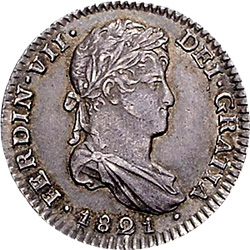
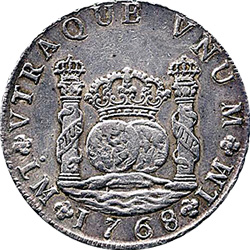
Spanish Colonial CoinsValues of Spanish Colonial Coins.
One of the most fascinating areas of world coin collecting is that of Spanish colonials. These coins circulated freely during the colonial period of the New World, both North America and South America. You can find essentially the same coins minted in the Spanish colonies of Bolivia, Chile, Columbia, Guatemala, Mexico, and Peru, from the early 1600s to the early 1800s. They circulated as far north as Canada and as far east as Florida.
These coins look alike, with subtle differences in mint marks and other small details, so it takes detailed knowledge to tell them apart. This page discusses some these details and gives approximate values. But, this is only a web page. Coin catalogs and reference books have much more detail. For instance, Spanish colonies in Dominican Republic, Venezuela, Nicaragua, and the Philippines produced small amounts of coinage, but they are not included here. There are also pre-1600 coins and small denominations not addressed. You can learn from this summary, but it is just a starting point.
It is important to know the kings of Spain during this period, as their names and portraits appear on many coins.
Philip III, 1598-1621
Philip IV, 1621-1665
Charles II, 1665-1700
Philip V, 1700-1746
Luis I, 1724
Fernando VI, 1746-1759
Carlos III, 1759-1788
Carlos IV, 1788-1808
Jose Napoleon, 1808-1813
Ferdinand VII, 1808-1833
Denominations - There are two major denominations of Spanish colonials: reales for silver coins and escudos for gold coins. The denominations have associated numeric values, e.g., one-quarter, one-half, 1, 2, 4, and 8. You can often tell the denomination by 'R' and 'S' marking for reales and escudos. For example, R = 1/2 real, 1R = 1 real, 2R = 2 reales, 2S = 2 escudos, and 8S = 8 escudos. There are 16 reales in one escudo.
Perhaps you have heard American folk tales with mysterious references to gold doubloons and pieces of eight. The escudos are the doubloons, and the reales are the pieces. In fact, the US monetary system has roots in Spanish reales, with 8 reales equivalent to one dollar, 4 reales to 50 cents, 2 reales 25 cents (two bits), one real 10 cents, and half real 5 cents.
The graphic figure on the left shows some typical denominational markings. A stand-alone number, 1, 2, 4, or 8, with or without an R or S, indicates denomination. Of course the size and weight of the coin indicates denomination as well. Generally, 8 reales contain about 0.8 troy ounces of silver and 8 escudos contain about 0.8 troy ounces of gold.
Mint Marks - Mint marks are important because they indicate the country of origin. The table below summarizes a few of the major mint marks for New World Spanish colonials. Spain herself is not included.
Armed with the background information above, we now look at individual design elements for Spanish colonials and give a hint of approximate value. No surprise, smaller coins such as 1 real or 1 escudo are generally worth less than larger coins such as 8 reales or 8 escudos. And, as always in coin collecting, coins in better condition are worth much more than coins in poorer condition. The descriptions below account for the major design elements for Spanish colonial coinage. There are a few designs not covered which are either very early or of very small denomination.

Silver with king's bust - Milled coins with a King's likeness are generally newer than other types, spanning from Carol III to Ferdinand VII (1759 to 1833). For large 8 reales coins values usually hover around the $200 mark for well-preserved coins. Curiously, 4 reales are generally more rare and command two or three times the value of 8 reales. A one real in average circulated condition is worth approximately $60 US dollars.
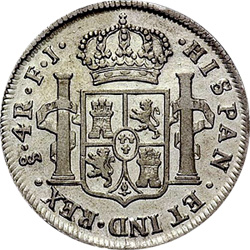

Crowned arms between pillars - This pattern is always paired with silver busts. The example in the picture is a 4 reales (4R) from Chile (Santiago mint) with assayer initials F and J. These are sometimes called pillar dollars, but there are other Spanish colonials with pillars, so the name is misleading. The coat of arms with lions and castles is a classic symbol of Spain.
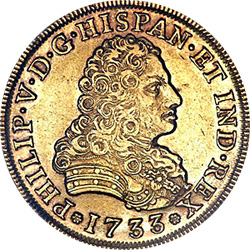

Gold with king's bust - Bust gold coins date as far back as Philip V and span through Ferdinand VII (1700 to 1833). These are valuable coins no matter how you look at them. Even small 1 escudo coins from Ferdinand sell near $400 US dollars in well preserved condition. Large 8 escudos can easily reach past $1000, and rare dates and early dates can hit $10,000 or higher. For instance, a 1764 8 escudos from Mexico with assayers MF catalogs at $11500 in well preserved condition.
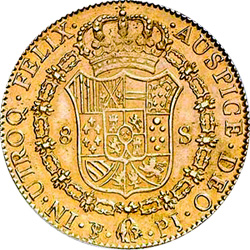

Gold flared arms with Order chain - This is the most recent reverse for bust gold Spanish colonials, starting around 1770. The coat of arms is flared a the top and encircled by a chain. The chain, with a sheepskin at the bottom, is from the Order of the Golden Fleece, an order of chivalry founded in 1430. The example in the picture is an 8 escudos (8S) from Bolivia (Potosi mint) with assayer initials P and J.
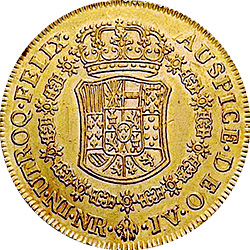

Gold tall arms with Order chain - The coat of arms on earlier (c. 1760 to 1770) bust escudos is slightly taller, slimmer, and less flared than the later design. Values are about the same as the gold bust coins already discussed. The coin in the picture is from Colombia (with the NR mint mark) but the denomination is not shown explicitly. It must be determined from the size and weight of the coin.


Gold royal arms with Order chain - The earliest bust milled gold coins had a royal Spanish arms on the reverse, starting in 1732 and continuing through about 1760. These are generally more valuable than more recent bust gold, cataloging, for instance, near $1000 for a well-preserved escudo and $5000 for a well-preserved 4 or 8 escudos. The same royal arms appears on silver coins. The gold coin in the picture is from Mexico (with the oM mint mark) but the denomination is not shown explicitly. It must be determined from the size and weight of the coin.


Gold royal arms no chain - Some of the smaller demonination gold bust coins omit the chain around the royal arms. Values are unaffected, or perhaps a tad higher than a chained design. There is also a silver version of this no-chain pattern.

Hemisheres between pillars - These are the pillar dollars most often referred to. The VTRAQUE VNUM (both are one) inscription appears over a Spanish crown that links Old and New Worlds together. The pillars bear a PLUS ULTRA (more beyond) inscription and are usually called the pillars of Hercules because the form a portal to both worlds, approached through the wavy sea beneath. Catalog values for these coins start around $30 US dollars for a worn 1 real and climb to $300 for a well-preserved 8 reales. The sample in the picture comes from Peru (Lima mint mark). Dates span from the 1730s to the 1770s.
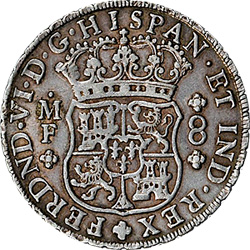

Silver royal arms - This pattern is paired with the Hemisphere between pillars pattern, and approximate values are explained there. These are almost always milled coins, but Guatemala used this pattern on a few cobs between 1733 and 1753. If you have a cob version, figure $25 to $400 catalog values (worn 1 real to well-preserved 8 reales). The coin in the picture is an 8 reales of Fernando VI with assayer initials MF. The other side has the mint mark (Mexico City).


Silver Jerusalem cross - Silver cobs from Mexico City have a Jerusalem cross on one side. The cross can be plain or with foils around it. Castles and lions appear in the angles of the cross. Cobs like this date back before 1600 to the early 1700s. Values start around $100 for small, poorly preserved coins and can go as high as $1000 for common-date, well-preserved 8 reales. Silver cobs were produced in Bolivia, Colombia, Mexico, and Peru.
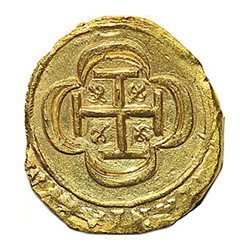

Gold Jerusalem cross - Almost all gold cobs have a Jerusalem cross on one side. The cross has prominent foils around it or a circle of dots. Sometimes castles and lions appear in the angles of the cross, but not always. The pictured coin has a quatrefoil and fluers de lis in the angles. These are very valuable coins. Catalog values start around $2500 for small, poorly preserved specimens and can easily reach $10000 for large, attractive 8 escudos. Gold cobs were produced in Colombia, Mexico, and Peru.
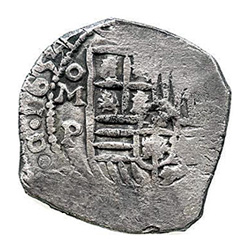

Silver crowned shield - A crowned shield with the Spanish coat of arms is often paired with the Jerusalem cross on silver cobs. Most of the time, only part of the design is actually visible. In the example here, the crown, which sits on top of the shield, is not at all present. But the oM (Mexico City) mint mark is plainly visible, the assayer initial P is visible, and a hint at the date (perhap 1654) also appears. Collectors will pay premiums for visible components such as these.


Gold crowned shield - A crowned shield with the Spanish coat of arms is often paired with the Jerusalem cross on gold cobs. Most of the time, only part of the design is actually visible. The example pictured is extraordinary. You can plainly see the crown, the oM (Mexico City) mint mark, the assayer initial I or J, and a clear date of 1714. The denomination does not show on the coin, but from its size and weigth it is easily identified as an 8 escudos. Further, turning to the coin catalogs which list all assayers, we know the intial is J, Jose E deLeon, who served as assayer between 1708 and 1723. This is a very valuable coin. Collectors will pay premiums for visible components such as these. Escudos with shields were produced only in Colombia and Mexico.
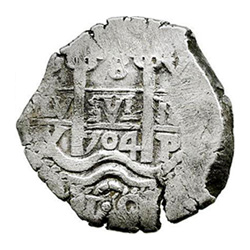

Silver pillars and waves - Instead of a crowned shield, some silver cobs use this pillars and waves design. Most of the time, only part of the design is actually visible. In the example here, the 8 at top center means 8 reales, and the 704 just above the waves is the date (1704). Collectors will pay premiums for visible components such as these. Silver reales with pillars and waves were produced only in Bolivia and Peru.
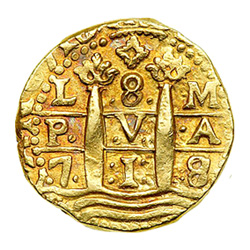

Gold pillars and waves - Instead of a crowned shield, some gold cobs use this pillars and waves design. Most of the time, only part of the design is actually visible. The example pictured is extraordinary. The L - 8 - M on the top row gives the mint mark (Lima), the denomination (8 escudos), and the assayer initial. The middle row, P - V - A, is an abbreviation for PLUS ULTRA or more beyond. The bottom row, just above the waves, gives the date as 1718. This is a very valuable coin. Collectors will pay premiums for visible components such as these. Escudos with pillars and waves were produced only in Peru.




 REVERS
REVERS E:
E:
























Types of Coins
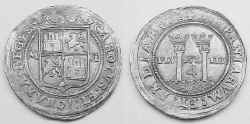



Pillar Type: The very first Spanish colonial silver coin design in the New World. Struck at the Mexico, Santo Domingo, and Lima mints in the time period of 1536 to 1572 - all undated.
Design Characteristics: Hand struck cob typically on a round full-sized planchet. One side has a pair of pillars with or without waves depending on the time period. The other side displays a simple shield with lions and castles in the four quadrants and with a pomegranate wedged in at the very bottom. Click here to view pillar type cobs offered for sale.
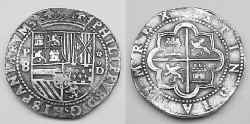
Design Characteristics: Hand struck cob typically on a round full-sized planchet. One side has a pair of pillars with or without waves depending on the time period. The other side displays a simple shield with lions and castles in the four quadrants and with a pomegranate wedged in at the very bottom. Click here to view pillar type cobs offered for sale.

Shield Type: The second type of Spanish colonial silver coin design in the New World. Struck at the Mexico, Santo Domingo, Lima, La Plata, Potosi, Panama, Cartagena, and Bogotá mints in the time period of 1572 to 1734. Dates first appeared in 1607 at the Mexico mint.
Design Characteristics: Hand struck cob, typically degrading in quality throughout the period. One side has a crowned multi-element shield representing the lands under Spanish control. The other side displays a cross with lions and castles in the four quadrants. Visit Atocha Coin Design for more information. Click here to view shield type cobs offered for sale.
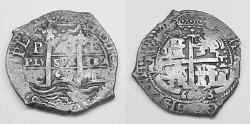
Design Characteristics: Hand struck cob, typically degrading in quality throughout the period. One side has a crowned multi-element shield representing the lands under Spanish control. The other side displays a cross with lions and castles in the four quadrants. Visit Atocha Coin Design for more information. Click here to view shield type cobs offered for sale.

Pillars and Waves Type: The third type of Spanish colonial silver coin design in the New World. Struck at the Bogotá, Potosi, Cartagena, and Lima mints in the time period of 1651 to 1773 - all with dates.
Design Characteristics: Hand struck cob, typically degrading in quality throughout the time period much like it's predecessor. One side has a pair of pillars with waves and two horizontal lines forming a tic-tac-toe design. The other side displays a cross with lions and castles in the four quadrants. Click here to view pillar and waves type cobs offered for sale.
The coins of Bogotá and Cartagena along with the transition coins of Potosi are slightly different in design, lacking the two horizontal lines forming the tic-tac-toe on the first side and incorporating a simple shield with lions and castles in the four quadrants in place of the cross on the other, as in the earlier pillar type.
Lima coins of 1659 and 1660 also lacked the two horizontal lines forming the tic-tac-toe on the first side, but did not change from the cross design on the other.

Design Characteristics: Hand struck cob, typically degrading in quality throughout the time period much like it's predecessor. One side has a pair of pillars with waves and two horizontal lines forming a tic-tac-toe design. The other side displays a cross with lions and castles in the four quadrants. Click here to view pillar and waves type cobs offered for sale.
The coins of Bogotá and Cartagena along with the transition coins of Potosi are slightly different in design, lacking the two horizontal lines forming the tic-tac-toe on the first side and incorporating a simple shield with lions and castles in the four quadrants in place of the cross on the other, as in the earlier pillar type.
Lima coins of 1659 and 1660 also lacked the two horizontal lines forming the tic-tac-toe on the first side, but did not change from the cross design on the other.

Milled Pillar Type: The fourth type of Spanish colonial silver coin design in the New World. Struck at the Mexico, Santiago (very rare), Lima, Guatemala, Bogotá (very rare) and Potosi mints in the time period of 1732 to 1772 - all with dates.
Design Characteristics: Machine struck on a full-sized round planchet. One side has a pair of pillars with waves separated by two overlapping globes crowned with a single crown. The other side displays a simple crowned shield with the typical lions, castles, and pomegranate but also with the centralized addition of three Fleurs-de-Lis. Click here to view milled pillar type coins offered for sale.
Guatemala coins struck between 1733 and 1753 were irregular in shape and thus considered to be cobs.
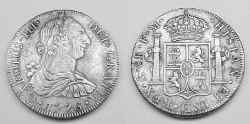
Design Characteristics: Machine struck on a full-sized round planchet. One side has a pair of pillars with waves separated by two overlapping globes crowned with a single crown. The other side displays a simple crowned shield with the typical lions, castles, and pomegranate but also with the centralized addition of three Fleurs-de-Lis. Click here to view milled pillar type coins offered for sale.
Guatemala coins struck between 1733 and 1753 were irregular in shape and thus considered to be cobs.

Milled Bust Type: The fifth and final type of Spanish colonial silver coin design in the New World. Struck at the Mexico, Lima, Bogotá, Guatemala, Potosi, Santiago, Popayan, and Cuzco mints in the time period of 1771 to 1825 - all with dates.
Design Characteristics: Machine struck on a round full-sized planchet. One side displays the bust of the King, the other side a pair of pillars separated by a crowned simple shield with lions, castles, pomegranate and the centralized three Fleurs-de-Lis. Click here to view milled bust type coins offered for sale.
Design Characteristics: Machine struck on a round full-sized planchet. One side displays the bust of the King, the other side a pair of pillars separated by a crowned simple shield with lions, castles, pomegranate and the centralized three Fleurs-de-Lis. Click here to view milled bust type coins offered for sale.
SPANISH COLONIAL COINS LIST


EARLY SERIES PILLARS, 1536-1541 MEXICO - TO 1600 (1538-41) 0.9310 Silver..4069 oz. ASW, 4R (1541)OMOOPO oMo, DOTTED CIRCLES CARLOS & JOHANNA


LATE SERIES PILLARS AND WAVES, 1544-1555 MEXICO - TO 1600 (1542-55) 0.9310 Silver..4069 oz. ASW, 4R (1542-55)M G CARLOS & JOANNA


INTRODUCING THE COB, 1572-1734 BOLIVIA - TO 1600 (1574-86) 0.9310 Silver..8102 oz. ASW, 8R (1574-86)P B PHILIP II
COB ERROR, 1574-1586 BOLIVIA - TO 1600 (1574-86) 8R (1574-79)P L KM-0005.1 "ISPANIARVM"
 REVERS
REVERS E:
E:
NEW BOLIVIAN COB DESIGN BOLIVIA - COLONIAL to 1824 (1747-78) 0.9170 Silver..7982 oz. ASW, 8R 1767P V Y P TYPE III KM-45


AN EMERGENCY BACKUP FOR NEW SCREW PRESS MEXICO - TO 1823 (1733-34) 0.9160 Silver, 8R 1733MO MF KLIPPE EX: ROOSWIJK WRECK


THE MEXICAN 8 REALES, PILLAR MEXICO - TO 1823 8R 1733MO F MILLED KM-103, GIL M-8-2


THE FIRST 8 REALES, PORTRAIT MEXICO - TO 1823 1773 -1784 0.9030 Silver..7858 oz. ASW, 8R 1775MO FM KM-106.2


Charles III, PICTURE LATE TO PERU PERU 1659-1826 0.8960 Silver, .7797 oz. ASW 8R 1788LIMA IJ Bust of Charles II, legend Charles III KM-78a


Charles IIII, PICTURE LATE TO PERU PERU 1659-1826 0.8960 Silver, .7797 oz. ASW, 8R 1790LIMA IJ LM Bust of Charles III, Legend Charles IV, KM# 87


CHARLES IIII PICTURE LATE TO MEX. MEXICO - TO 1823 0.9030 Silver .7858 oz. ASW, 8R 1790MO FM "CAROLUS IIII" CHARLES III BUST KM 108


CHARLES IIII PICTURE ARRIVED MEX. MEXICO - TO 1823 0.8960 Silver. .7797 oz. ASW. 8R 1794MO FM KM# 109


FERDINAND VII PICTURE LATE TO PERU PERU 1659-1826 1808-1809 0.8960 Silver, .7797 oz. ASW 8R 1808LIMA JP FERDINAND VII LARGE IMAGINED BUST KM# 106.1
FERDIN VII PICTURE LATE TO CHILE CHILE - COLONIAL 1808 to 1809 0.8960 Sliver. .7797 oz. ASW 8R 1808SO FJ "FERDIN VII" KM# 68
CHILE STILL WAITING FERDIN VII PICTURE CHILE - COLONIAL 1810-1811 0.8960 Silver, .7797 oz. ASW 8R 1810SO FJ SO KM# 75


MEXICO WAITING FOR FERDIN VII PICTURE MEXICO - TO 1823 ,1808 to 1809 0.8960 Silver, .7797 oz. ASW, 8R 1809MO TH ,KM# 110


PERU WAITING FOR FERDIN VII PICTURE PERU 1659-1826 ,1809-1811 0.8960 Silver, .7797 oz. ASW, 8R 1811LIMA JP IMAGINED BUST KM# 106.2


FERDIN VII PICTURE ARRIVED MEXICO FREDINAND VII PICTURE ARRIVED MEX. MEXICO - TO 1823 ,1811 TO 1821 0.9030 Silver .7859 oz. ASW, 8R 1821MO JJ KM# 111


THE END OF SPANISH RULE PERU 1659-1826 ,1824/3 0.8960 Silver..7797 oz. ASW, 8R 1824CUZCO T CUZ, 1824/3, KM# 117.2
